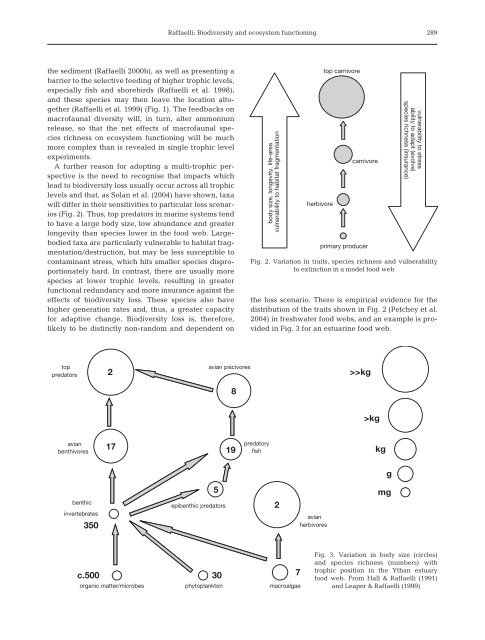Biodiversity and ecosystem functioning: issues of scale and trophic ...
Biodiversity and ecosystem functioning: issues of scale and trophic ...
Biodiversity and ecosystem functioning: issues of scale and trophic ...
You also want an ePaper? Increase the reach of your titles
YUMPU automatically turns print PDFs into web optimized ePapers that Google loves.
Raffaelli: <strong>Biodiversity</strong> <strong>and</strong> <strong>ecosystem</strong> <strong>functioning</strong>289the sediment (Raffaelli 2000b), as well as presenting abarrier to the selective feeding <strong>of</strong> higher <strong>trophic</strong> levels,especially fish <strong>and</strong> shorebirds (Raffaelli et al. 1998),<strong>and</strong> these species may then leave the location altogether(Raffaelli et al. 1999) (Fig. 1). The feedbacks onmacr<strong>of</strong>aunal diversity will, in turn, alter ammoniumrelease, so that the net effects <strong>of</strong> macr<strong>of</strong>aunal speciesrichness on <strong>ecosystem</strong> <strong>functioning</strong> will be muchmore complex than is revealed in single <strong>trophic</strong> levelexperiments.A further reason for adopting a multi-<strong>trophic</strong> perspectiveis the need to recognise that impacts whichlead to biodiversity loss usually occur across all <strong>trophic</strong>levels <strong>and</strong> that, as Solan et al. (2004) have shown, taxawill differ in their sensitivities to particular loss scenarios(Fig. 2). Thus, top predators in marine systems tendto have a large body size, low abundance <strong>and</strong> greaterlongevity than species lower in the food web. Largebodiedtaxa are particularly vulnerable to habitat fragmentation/destruction,but may be less susceptible tocontaminant stress, which hits smaller species disproportionatelyhard. In contrast, there are usually morespecies at lower <strong>trophic</strong> levels, resulting in greaterfunctional redundancy <strong>and</strong> more insurance against theeffects <strong>of</strong> biodiversity loss. These species also havehigher generation rates <strong>and</strong>, thus, a greater capacityfor adaptive change. <strong>Biodiversity</strong> loss is, therefore,likely to be distinctly non-r<strong>and</strong>om <strong>and</strong> dependent onbody size, longevity, life-areavulnerability to habitat fragmentationherbivoretop carnivorecarnivoreprimary producervulnerability to stressability to adapt (evolve)species richness (insurance)Fig. 2. Variation in traits, species richness <strong>and</strong> vulnerabilityto extinction in a model food webthe loss scenario. There is empirical evidence for thedistribution <strong>of</strong> the traits shown in Fig. 2 (Petchey et al.2004) in freshwater food webs, <strong>and</strong> an example is providedin Fig. 3 for an estuarine food web.toppredators2avian piscivores>>kg8>kgavianbenthivores1719predatoryfishkggbenthicinvertebrates3505epibenthic predators2avianherbivoresmgc.500307organic matter/microbes phytoplankton macroalgaeFig. 3. Variation in body size (circles)<strong>and</strong> species richness (numbers) with<strong>trophic</strong> position in the Ythan estuaryfood web. From Hall & Raffaelli (1991)<strong>and</strong> Leaper & Raffaelli (1999)
















